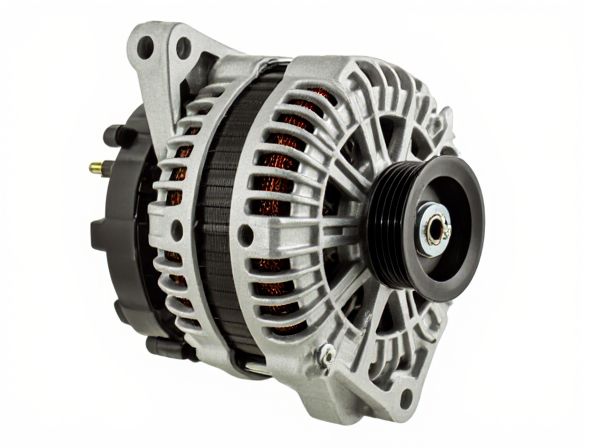
Photo illustration: Single-Phase Rectifier vs Three-Phase Rectifier
Single-phase rectifiers convert AC to DC using one alternating current input, offering simplicity and cost-effectiveness for low-power applications. Three-phase rectifiers utilize three AC inputs that produce smoother and more stable DC output with less ripple, ideal for high-power and industrial uses. Understanding your power requirements helps determine whether a single-phase or three-phase rectifier best suits your electrical system.
Table of Comparison
| Feature | Single-Phase Rectifier | Three-Phase Rectifier |
|---|---|---|
| Output Voltage | Lower, pulsating DC | Higher, smoother DC |
| Efficiency | Moderate, higher losses | High, reduced ripple losses |
| Ripple Current | High ripple, requires large filtering | Low ripple, easier filtering |
| Power Delivery | Limited, less stable output | Stable, suitable for high load |
| Application | Basic automotive alternators, low-cost models | Modern automotive alternators, heavy-duty vehicles |
| Cost | Lower initial cost | Higher initial cost, better performance |
Introduction to Rectifiers
Rectifiers convert alternating current (AC) to direct current (DC), essential for power supplies in electronics and industrial applications. Single-phase rectifiers typically handle lower power loads and produce higher ripple content in the output voltage. Three-phase rectifiers provide smoother DC output with lower ripple, higher efficiency, and are preferred for high-power industrial equipment.
What is a Single-Phase Rectifier?
A single-phase rectifier converts alternating current (AC) from a single-phase power supply into direct current (DC) by using diodes arranged in a specific configuration. It is commonly used in low-power applications where a simple and cost-effective DC power supply is required. Single-phase rectifiers provide lower output voltage ripple compared to three-phase rectifiers but typically offer less power handling capacity and efficiency.
What is a Three-Phase Rectifier?
A three-phase rectifier is an electronic device that converts three-phase AC voltage into DC voltage, commonly used in industrial and power applications to provide a steady and efficient power supply. Compared to single-phase rectifiers, it produces smoother DC output with less ripple due to the continuous conduction during each phase of the AC cycle. This characteristic enhances performance in high-power systems such as motor drives, battery charging, and HVDC transmission.
Working Principle: Single-Phase vs Three-Phase
Single-phase rectifiers convert AC to DC using one alternating voltage source and typically employ two or four diodes to control the current flow during each AC cycle, resulting in periodic pulsating DC output with higher ripple. Three-phase rectifiers utilize three AC sources phase-shifted by 120 degrees and use six diodes, enabling continuous conduction and smoother DC output with reduced ripple due to overlapping phases. The working principle difference lies in phase utilization, where three-phase rectifiers provide more stable and efficient DC output than single-phase rectifiers by leveraging multiple phase inputs simultaneously.
Circuit Configurations and Components
Single-phase rectifiers typically use one or two diodes in either half-wave or full-wave configurations, making their circuits simpler and suitable for low-power applications; the primary components include a single transformer, diodes, and a smoothing capacitor. Three-phase rectifiers use six diodes arranged in a bridge configuration to efficiently convert AC to DC across three input phases, enhancing power output and reducing ripple, with components including a three-phase transformer, six diodes or thyristors, and larger filtering elements. The complexity and component count in three-phase rectifiers support higher power handling and improved performance compared to the simpler single-phase rectifier circuits.
Output Voltage and Efficiency Comparison
Single-phase rectifiers typically provide lower output voltage and exhibit higher ripple content compared to three-phase rectifiers, which deliver more stable and higher DC output voltage due to continuous conduction in multiple phases. The efficiency of three-phase rectifiers surpasses single-phase units, often exceeding 95%, as the power conversion is smoother with reduced losses from lower harmonic distortion and heat dissipation. Consequently, three-phase rectifiers are favored in industrial applications requiring high power and efficiency, while single-phase rectifiers are more common in low-power or residential scenarios.
Ripple Factor and Power Quality
Single-phase rectifiers typically exhibit higher ripple factor values, often ranging from 0.48 to 0.65, resulting in poorer power quality due to increased harmonic distortion and voltage fluctuations. In contrast, three-phase rectifiers substantially reduce ripple factor to values around 0.05 to 0.15, delivering smoother DC output and enhanced power quality with minimized harmonic content. Lower ripple factor in three-phase systems translates to improved efficiency, reduced electromagnetic interference, and better performance in industrial power conversion applications.
Applications of Single-Phase Rectifiers
Single-phase rectifiers are commonly used in low-power applications such as battery chargers, small power supplies, and household appliances due to their simplicity and cost-effectiveness. They efficiently convert AC to DC in devices requiring lower voltage and current levels, making them ideal for domestic and portable equipment. Industrial environments typically favor three-phase rectifiers for high power demands, while single-phase rectifiers remain optimal for localized, lightweight electrical circuits.
Applications of Three-Phase Rectifiers
Three-phase rectifiers are extensively used in industrial applications requiring high power and efficiency, such as motor drives, HVDC power transmission, and welding equipment. Their ability to provide smoother DC output with less ripple makes them ideal for large-scale power conversion and renewable energy systems. These rectifiers support heavy electrical loads, improving performance in electric trains, battery charging stations, and electrochemical processes.
Choosing the Right Rectifier for Your Needs
Selecting the right rectifier depends on your power requirements and application. Single-phase rectifiers are suitable for low power, simple setups, offering cost-effectiveness and ease of use, while three-phase rectifiers provide higher efficiency, reduced ripple, and are ideal for industrial or high-power applications. Analyzing load demands, voltage stability, and harmonic distortion helps determine the optimal choice between single-phase and three-phase rectification for enhanced performance.
 caratoz.com
caratoz.com